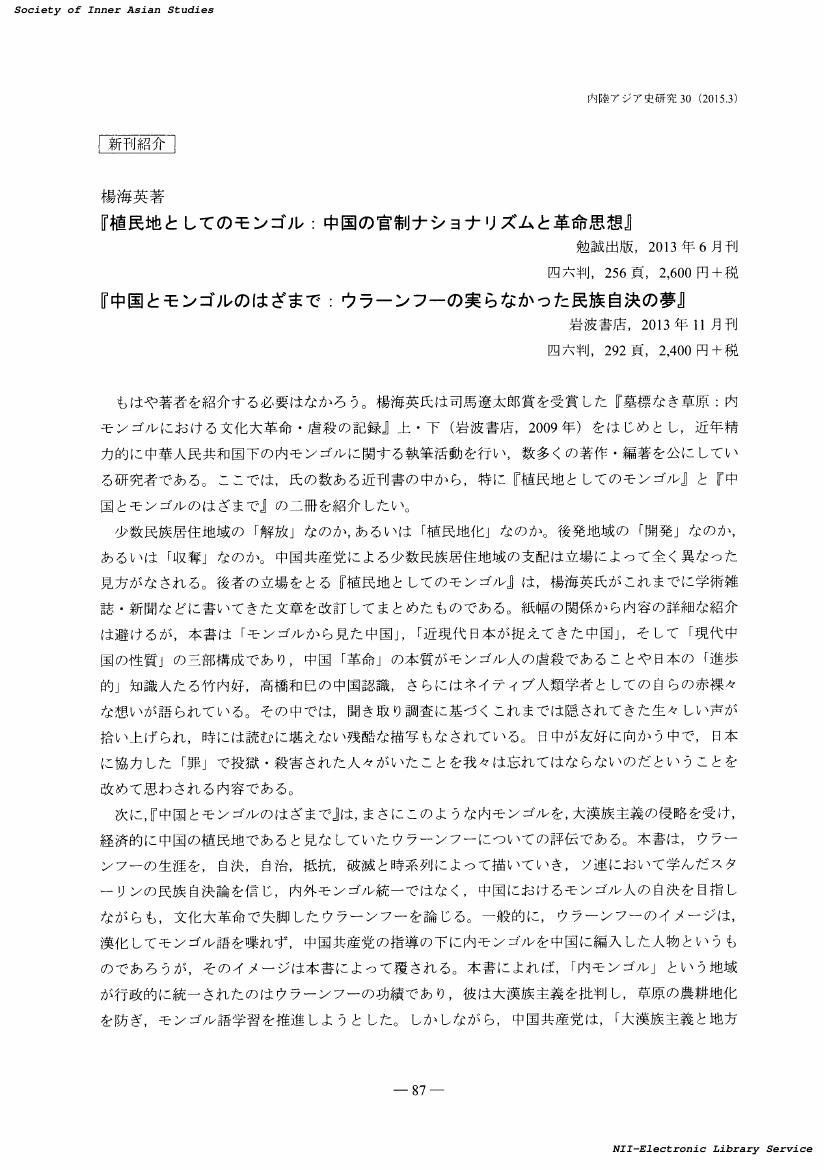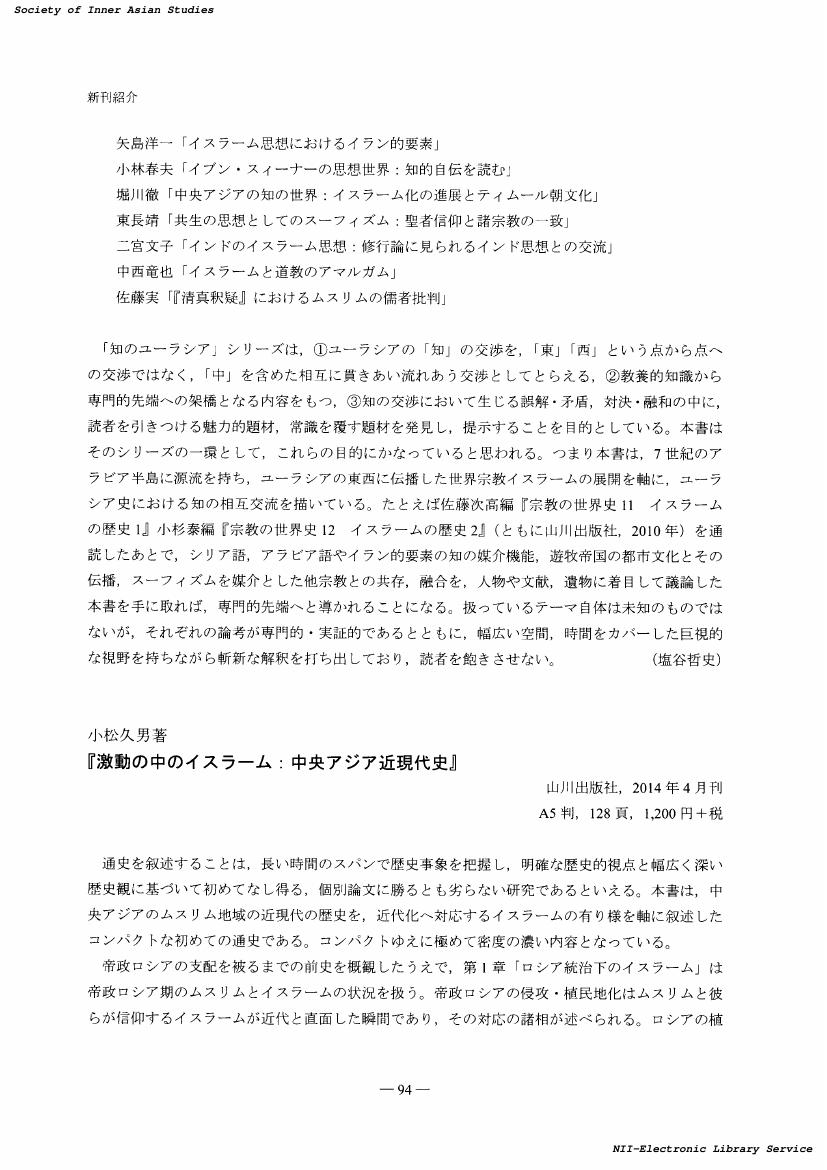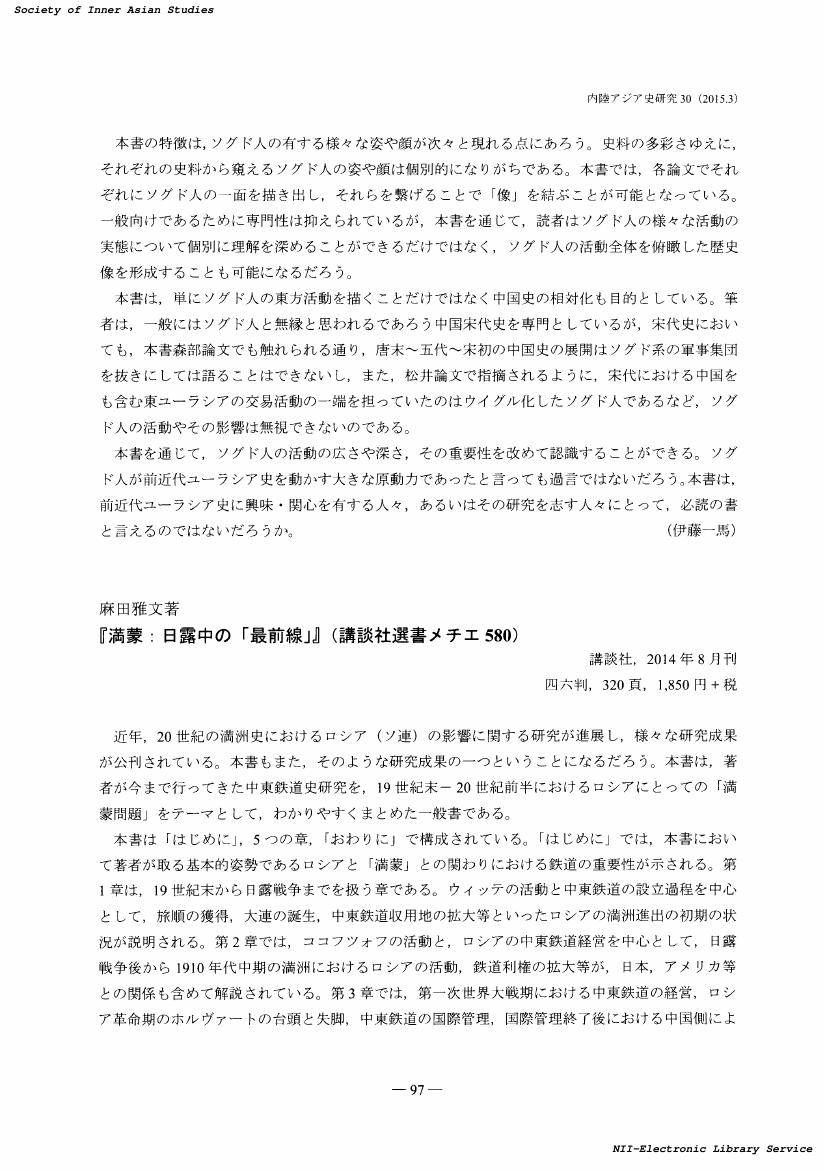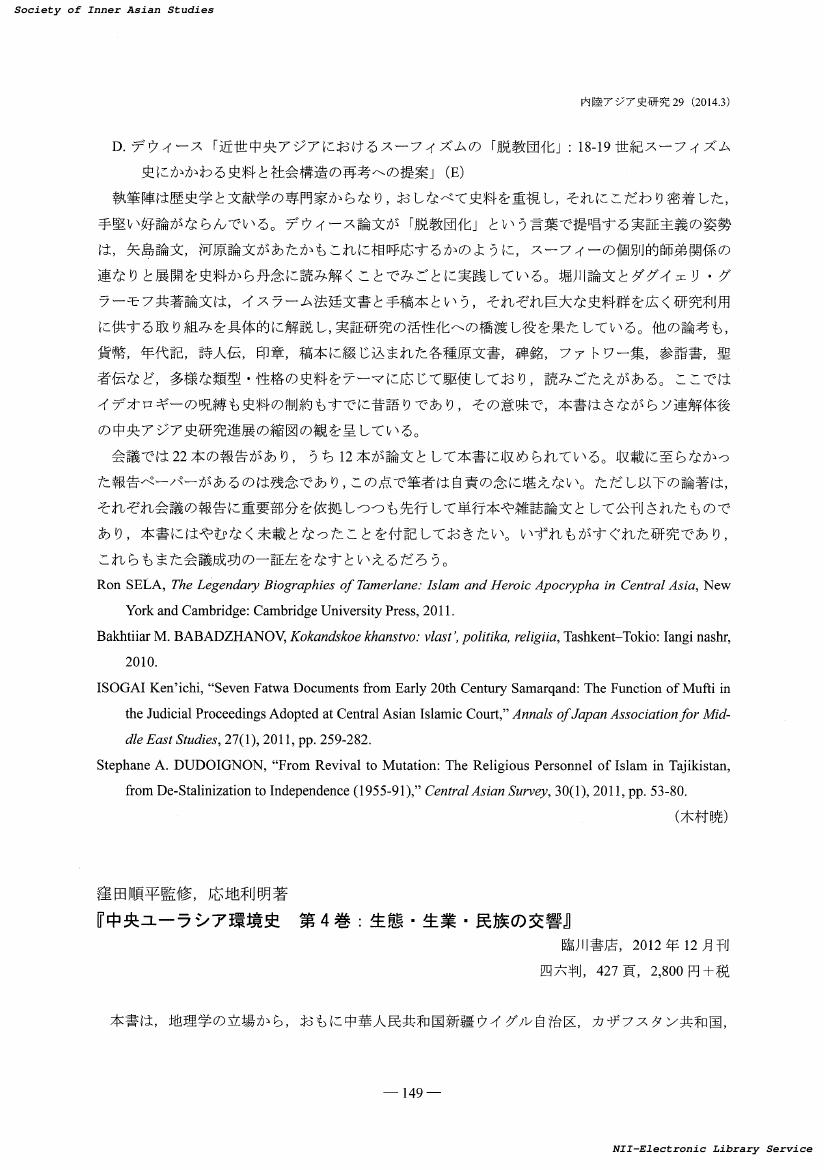1 0 0 0 OA 編集後記
- 出版者
- 内陸アジア史学会
- 雑誌
- 内陸アジア史研究 (ISSN:09118993)
- 巻号頁・発行日
- vol.30, pp.App1, 2015-03-31 (Released:2017-10-10)
- 著者
- 長沼 秀幸
- 出版者
- 内陸アジア史学会
- 雑誌
- 内陸アジア史研究 (ISSN:09118993)
- 巻号頁・発行日
- vol.30, pp.77-85, 2015-03-31 (Released:2017-10-10)
- 著者
- 橘 誠
- 出版者
- 内陸アジア史学会
- 雑誌
- 内陸アジア史研究 (ISSN:09118993)
- 巻号頁・発行日
- vol.30, pp.87-88, 2015-03-31 (Released:2017-10-10)
- 著者
- 藤原 崇人
- 出版者
- 内陸アジア史学会
- 雑誌
- 内陸アジア史研究 (ISSN:09118993)
- 巻号頁・発行日
- vol.30, pp.88-89, 2015-03-31 (Released:2017-10-10)
- 著者
- 植田 暁
- 出版者
- 内陸アジア史学会
- 雑誌
- 内陸アジア史研究 (ISSN:09118993)
- 巻号頁・発行日
- vol.30, pp.89-90, 2015-03-31 (Released:2017-10-10)
- 著者
- 菅原 純
- 出版者
- 内陸アジア史学会
- 雑誌
- 内陸アジア史研究 (ISSN:09118993)
- 巻号頁・発行日
- vol.30, pp.91-92, 2015-03-31 (Released:2017-10-10)
- 著者
- 長峰 博之
- 出版者
- 内陸アジア史学会
- 雑誌
- 内陸アジア史研究 (ISSN:09118993)
- 巻号頁・発行日
- vol.30, pp.92-93, 2015-03-31 (Released:2017-10-10)
- 著者
- 塩谷 哲史
- 出版者
- 内陸アジア史学会
- 雑誌
- 内陸アジア史研究 (ISSN:09118993)
- 巻号頁・発行日
- vol.30, pp.93-94, 2015-03-31 (Released:2017-10-10)
- 著者
- 真田 安
- 出版者
- 内陸アジア史学会
- 雑誌
- 内陸アジア史研究 (ISSN:09118993)
- 巻号頁・発行日
- vol.30, pp.94-96, 2015-03-31 (Released:2017-10-10)
- 著者
- 伊藤 一馬
- 出版者
- 内陸アジア史学会
- 雑誌
- 内陸アジア史研究 (ISSN:09118993)
- 巻号頁・発行日
- vol.30, pp.96-97, 2015-03-31 (Released:2017-10-10)
- 著者
- 青木 雅浩
- 出版者
- 内陸アジア史学会
- 雑誌
- 内陸アジア史研究 (ISSN:09118993)
- 巻号頁・発行日
- vol.30, pp.97-98, 2015-03-31 (Released:2017-10-10)
- 著者
- 承志
- 出版者
- 内陸アジア史学会
- 雑誌
- 内陸アジア史研究 (ISSN:09118993)
- 巻号頁・発行日
- vol.29, pp.182, 2014-03-31 (Released:2017-10-10)
- 著者
- 山本 明志
- 出版者
- 内陸アジア史学会
- 雑誌
- 内陸アジア史研究 (ISSN:09118993)
- 巻号頁・発行日
- vol.29, pp.182-183, 2014-03-31 (Released:2017-10-10)
1 0 0 0 OA ハン,企業家,帝国 : ラウザーン運河をめぐるロシア=ヒヴァ・ハン国関係の変遷 一八七三-一九一七年(公開講演・研究発表要旨,2013(平成25)年度内陸アジア史学会大会記事,彙報)
- 著者
- 塩谷 哲史
- 出版者
- 内陸アジア史学会
- 雑誌
- 内陸アジア史研究 (ISSN:09118993)
- 巻号頁・発行日
- vol.29, pp.183-184, 2014-03-31 (Released:2017-10-10)
1 0 0 0 OA 編集後記
- 出版者
- 内陸アジア史学会
- 雑誌
- 内陸アジア史研究 (ISSN:09118993)
- 巻号頁・発行日
- vol.29, pp.App1, 2014-03-31 (Released:2017-10-10)
1 0 0 0 OA ティムール朝期の「一日行程」と駅伝制
- 著者
- 早川 尚志
- 出版者
- 内陸アジア史学会
- 雑誌
- 内陸アジア史研究 (ISSN:09118993)
- 巻号頁・発行日
- vol.30, pp.23-49, 2015-03-31 (Released:2017-10-10)
As is usually the case with Inner Asian dynasties that ruled vast territories, the Timurid Dynasty operated a postal system, which encompassed an extensive web of postal stations. This system was instrumental in allowing the Timurids to acquire information rapidly, and it also facilitated the movement of both military personnel and civilians. The system was also used for time-tracking: For instance, citing how many postal stations there were between two cities proved to be a relatively reliable way of calculating distance. This truly demonstrates the importance of the postal system under the Timurid Dynasty, especially as far as transport is concerned. In this paper, I examine the postal station as a criterion of time-tracking and relate it to a unit called farsah or farsang. I also discuss the way in which the Timurid Dynasty could retain and manage the postal station as a constant criterion. Specifically, I examine the system of postal stations, the permission needed in order to conduct a journey, how such permission was acquired, who could supply such permission, the benefits of such permission, and the support of the siqa'uls. The results of my investigation demonstrate how the Timurid rulers kept this web of postal stations in their lands and how they used them in order to obtain valuable information as quickly as possible, especially during emergencies.
1 0 0 0 OA 偽経本「八陽経」写本からみた仏教文化史の展望
- 著者
- 小田 壽典
- 出版者
- 内陸アジア史学会
- 雑誌
- 内陸アジア史研究 (ISSN:09118993)
- 巻号頁・発行日
- vol.30, pp.51-68, 2015-03-31 (Released:2017-10-10)
This note is a brief view of the Buddhist scripture translated into the Turkic language from the apocryphal Chinese Bayangjing, referring to the relationship between the other translations in Tibetan and Mongolian. Judging from the quantitative and linguistic abundance of extant fragments and their rich content, there can be discussion that this scripture circulated widely and over a long period of time among Uighur Buddhists. It should also be noted that the Bayangjing which was not included in the official canon, includes scathing criticism of the yin-yang theory and undue concern for good and bad fortune. According to Overmyer's review (1990: 213), this work may be a Buddhist gospel of liberation from taboos and divination. We will study on the influence of Uighur Buddhism in Mongolian translations of the thirteenth and fourteenth centuries through a comparative study of the Mongolian and Turkic translations of the Bayangjing. And also it is very interesting that various Tibetan translations of the Bayangjing deal with the relations between Chinese originals.
- 著者
- 小松原 ゆり
- 出版者
- 内陸アジア史学会
- 雑誌
- 内陸アジア史研究 (ISSN:09118993)
- 巻号頁・発行日
- vol.30, pp.69-76, 2015-03-31 (Released:2017-10-10)
- 著者
- 木村 暁
- 出版者
- 内陸アジア史学会
- 雑誌
- 内陸アジア史研究 (ISSN:09118993)
- 巻号頁・発行日
- vol.29, pp.148-149, 2014-03-31 (Released:2017-10-10)
- 著者
- 塩谷 哲史
- 出版者
- 内陸アジア史学会
- 雑誌
- 内陸アジア史研究 (ISSN:09118993)
- 巻号頁・発行日
- vol.29, pp.149-150, 2014-03-31 (Released:2017-10-10)

















